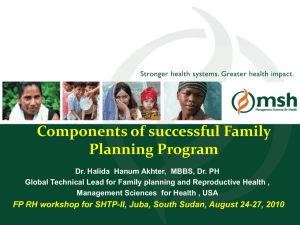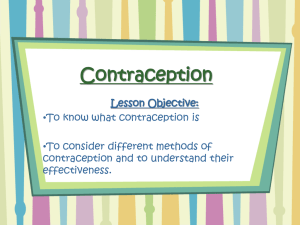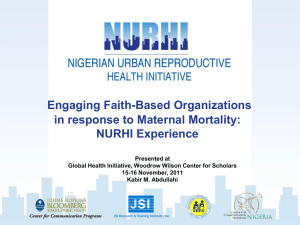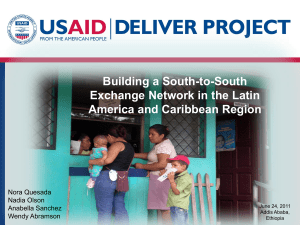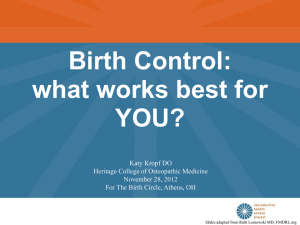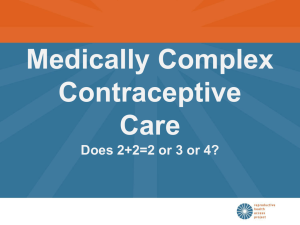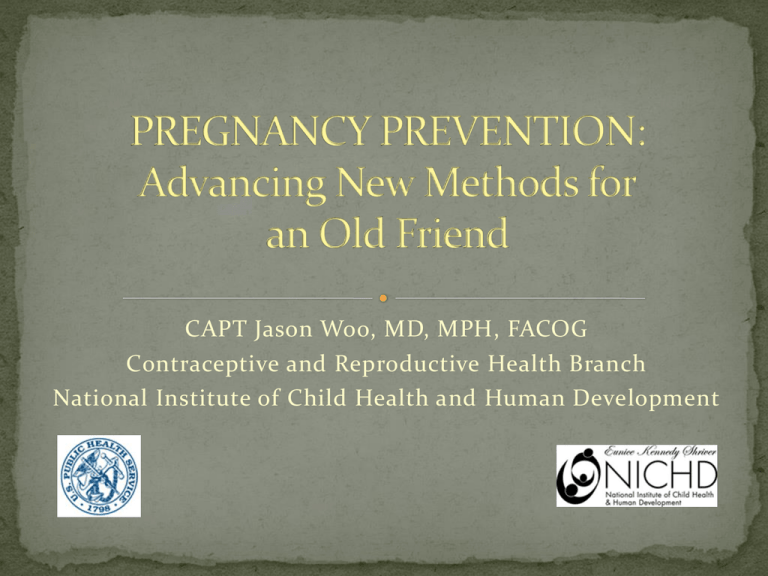
CAPT Jason Woo, MD, MPH, FACOG
Contraceptive and Reproductive Health Branch
National Institute of Child Health and Human Development
Identify gaps in the use of existing contraceptive methods
to prevent unintended pregnancies.
Describe novel areas for development of alternative forms
and types of contraceptive methods.
Describe the leadership role of the National Institute of
Child Health and Human Development in developing and
collaborating with other stakeholders to advancing new
contraceptive methods to address the problem of
unplanned pregnancy around the world.
Why pregnancy prevention remains a challenge
What is the future for new contraceptive methods
What are we doing now
On October 31, 2011, the 7
billionth person, was born in
poverty in Africa or Asia
According to a new report from the
prestigious London School of Economics,
birth control is a less expensive way to
reduce carbon dioxide emissions than most
green energy strategies. March 18, 2009
Bloomberg News
2010
A pregnancy that is either….
mistimed (occurs earlier than desired)
Or
unwanted (is not wanted at all)
at the time of conception
What is an Unplanned Pregnancy”?
A pregnancy that occurred when the woman used a contraceptive
method or when she did not desire to become pregnant but did not
use a method.
Planning status and outcome of all
pregnancies in developing countries
2008
120
Pregnancy Planning Status
Pregnancy Outcome
Percent of All Pregnancies
100
Abortion
80
Unintended
60
Unintended Birth
Miscarriage
40
Intended
20
0
Source: S. Singh et al Studies in Family Planning 41, 241-250 (2010).
Intended Birth
In 2008, 86 million (41%) of 208 million pregnancies
globally were unintended
The proportions of live births reported as mistimed or
unwanted varies by country, but overall are approximately
equal
Sources: Singh et al, 2010; Bradley et al, 2011
Intended
Unintended
100%
90%
80%
30
38
38
43
46
47
48
70%
59
64
41
36
60%
50%
40%
30%
70
62
62
57
54
20%
53
52
10%
0%
Western
Africa
Northern
Africa
Source: Singh et al, 2010
Southcentral Asia
Central
America
Eastern
Africa
More
SouthSouthern
developed eastern Asia
Africa
regions
South
America
Higher infant/maternal mortality
Less breastfeeding
Less preventive care and treatment
More infant illnesses
More undernourished children
Abandonment, fostering, adoption
Fewer educational and development opportunities
for the woman
More children than desired or can be supported
Source: Gipson et al, 2008; Malacher et al, 2010
High rate of abortions
Greater maternal morbidity and mortality in countries
where abortion is illegal and unsafe
Physical Abuse and Violence during pregnancy
Greater household dysfunction
History of greater exposure to psychological, physical
and sexual abuse during the woman’s childhood
South-central Asia
West Africa
Unplanned
births
33
53
Abortions
South America
39
Abortions
47
More Developed
Unplanned
births
38
48
Unplanned
births
32
Abortions
53
Unplanned
births
Abortions
• Unmet need: Non-use of contraception – when
sexually active and a pregnancy is not
desired
• Switching or discontinuing a contraceptive
method
• Incorrect use or method failure
• Unplanned sex
• Unwanted sex
Non-consensual and/or violent sex
Early marriage
The total fertility rate would be 4-29% lower without
failure
More than half of the total unwanted fertility rate
is due to either a contraceptive failure or a
contraceptive discontinuation
The total unwanted fertility rate would be between 0.2
and 1.1 births lower without failure and discontinuation
Blanc et al, 1999
Women with unmet need for contraceptives, 2008
Access-related and
other concerns
Method related
concerns
104 million women living in Sub-Saharan Africa, South
Central Asia, Southeast Asia with method-related reasons for
non-use; Darroch et al 2011
Full range and complexity of women’s concerns about individual
methods
How specific method characteristics can hamper choice and use
Reasons for choosing traditional methods rather than modern
methods
Clarification of meaning of “other reasons” for non-use
Reasons for long-term vs. short-term non-use
Sub-group differences in unmet need and in outcomes of non-use
“Acceptability Research”
Source: Darroch et al, 2011
Consistent
use, method
failed,
5%
Inconsistent or
incorrect use,
43%
Nonuse,
52%
3.1 million unintended pregnancies,
by women's contraceptive use during month of
conception
No use,
8%
Consistent ,
correct use,
50%
Gap in use of
1 month or
more,
15%
Inconsistent
or incorrect
use,
27%
28 million adult women at risk for unintended
pregnancy
Delay f irst birth
74%
58%
Space births
49%
Married
<20
20-24
62%
25-34
59%
35+
58%
Poor
70%
56%
Rural
68%
49%
0%
20%
40%
34%
60%
80%
7%
72%
37%
33%
30%
30%
68%
Urban
25%
55%
46%
Nonpoor
63%
30%
64%
Unmarried
78%
32%
29%
70%
Stop births
South Central Asia
Southeast Asia
Sub-Saharan Africa
100%
0%
20%
51%
33%
23%
40%
33%
29%
29%
30%
31%
35%
29%
40%
60%
80%
100%
% of women with unmet need for modern methods
0%
20%
40%
60%
80%
100%
1.
Unintended pregnancies can lead to unwanted births, which may have
adverse outcomes for mother and child(ren)
2. Unintended pregnancies can lead to unsafe abortion, which may have
adverse outcomes for the mother
3. The majority of unintended pregnancies can be prevented through
reducing unmet need for effective, appropriate contraceptive methods
4. Over two-thirds of unmet need is attributed to method-related issues
less than one-third to access-related issues
5. However, a substantial proportion of unintended pregnancies result from
failure, discontinuation and switching
6. The right to choose the number and spacing of births through having
only intended pregnancies is most neglected among poor, young, rural
women
Acceptability
Better user efficacy
Fewer systemic side effects
Additional beneficial effects to use (Multi-use product)
Avoids cultural-social/religious barriers
Usability
Does not require skilled intermediary
Easier management of side effects
Can be used on-demand
Suited to diverse requirements imposed by the variety of
conditions throughout the world
Access
Do not cause systemic side effects
Can be used on demand
Do not require partner participation or knowledge
Benefits of New Technologies
Reduce user’s dependence on trained providers
Suited to diverse requirements imposed by the variety of
conditions throughout the world
New Frontiers in Contraceptive
Research: A Blueprint for Action
Released: January 20, 2004
13 Primary Recommendations
Promising New Targets
Key Areas for discovery:
Male spermatogenesis pathway
Sperm maturation (both sperm and epididymal proteins)
Sperm capacitation, motility and chemotaxis in the female
reproductive tract
Proteins and molecules in the female reproductive system
(vagina, cervix, uterus and oviduct) – focus on epithelium
Sperm-egg interactions (both sperm and egg proteins and
molecules)
Maturation and ovulation of the egg
Oocyte
Spermatogenesis
Differentiation
Stem cells
Meiosis
Spermiogenesis
Maturation
Function
Binding
Sperm-Zona Interaction
Trimming
Motility
Acrosomal Reaction
Glycoprocessing Orientation
Capacitation
Fusion ??
Environment
Genes Involved in the
Regulation of Male
Reproduction in the
Mouse
Non-hormonal methods that regulate ovulation are
in the early stages of exploration.
Ovulatory-selective expression library
31 ovulation-selective
13 ovulation-specific
(Hourvitz et al, J Endocrinol 2006)
Phosphodiesterase 3 inhibitors
(Jensen et al, Contraception 2005)
Progesterone receptor modulators
Validated targets are only useful if compounds can be
identified to modulate those targets in humans
Selection of lead molecules for development remains a
challenge
Need a high throughput drug discovery approach
Heinemann et al 2005 J Androl –
Expectations toward a novel male fertility control
method and potential user types: results of a
multinational survey.
Lye et al 2004 Mol Cell Endocrinol –
Male contraception – a topic with many facets.
Anderson & Baird 2000 Endocrine Reviews –
Male Contraception
Glasier et al 2000 Human Reproduction –
Would women trust their partners to use a male pill?
Do Men Want a Male Contraceptive?
Heinemann et al 2005 J Androl. Expectations toward a novel male fertility control method…
The Sex-Oriented
Narcissist
The Religious
Refuser
The Informed
Countries
Germany
Sweden
France
Spain
United States
Mexico
Argentina
Brazil
Indonesia
27.6
24.5
43.3
42.4
49.4
50.2
34.8
65.1
43.9
10.5
11.4
13.1
15.8
23.2
32.6
15.4
23.4
53.8
61.9
64.1
43.6
41.8
27.4
17.1
49.8
11.5
2.3
Who decides on
contraceptive method?
You
Partner
Both
3.7
19.3
77.0
6.3
39.6
54.1
6.3
12.2
81.5
If available, would you
be willing to use MC?
Willing
Uncertain
Disapproving
56.7
24.0
19.3
39.3
26.6
34.1
64.2
20.9
14.9
Inadequate attention and resources
Target Criteria Considerations – which to develop
Shift in focus from discovery to adaptation
Customer Population
Healthy
Product for preventive use (extended exposure) vs disease
use
Contracepting for a significant part of their lives (> 30 yrs)
Safety / Side Effect Profile
Product Acceptability
Cultural Issues
Male Role
Side Affects
Conduct and support research and training to
develop new contraceptive methods for men and
women.
Conduct and support research on the safety and
efficacy of existing contraceptive methods.
Support research and training in selected areas of
Reproductive Health with a special focus on pelvic
floor disorders.
Research
Contract
For New
Development
Contraceptive
Centers Grants (U54)
Male Contraceptive
Development Program (U01)
Small
Business,
Academic
Researchers
Support Contracts
Biological Testing Facility
Chemical Synthesis Facility
Peptide Synthesis Facility
Investigator
Initiated
Grants
Contraceptive
Clinical Trials
Network
Progesterone Receptor Modulators
CDB-2914 (licensed to HRA Pharma and marketed in Europe)
Approved by FDA, August 13, 2010
CDB-4124 (licensed to Repros Therapeutics)
Estrogen
Estradiol dinitrate ester (CDB-1357) (Evestra is licensing)
GnRH antagonist
Acyline (CDB-3883)
Progestin
Levonorgestrel butanoate (CDB-1830) Jointly developed with WHO
Androgenic Steroids
Dimethandrolone undecanoate (CDB-4521)
11β-methyl-19 nortestosterone 17β-dodecylcarbonate (CDB-4730)
Nonhormonal antispermatogenic agents
Indenopyridine (CDB-4022)
Lonidamine analog (CDB-4776)
Variety of mechanisms; e.g. R01, R03, R21, R43, R44
Example areas of research include:
Effects of hormonal contraceptives on bone density
Male sterilization – intra vas device
Female sterilization – thermal transcervical device
Effect of continuous versus sequential OCs
FSH antisense strategy for contraception
Identification of male contraceptive lead compounds
Selective blockers of oocyte maturation
Progestin effects on uterine hemostasis and angiogenesis
Amory, J; University of Washington,
Seattle, WA
BDADs as a male contraceptive
Clapham, D; Children's Hospital,
Boston, MA
Male contraception/CatSper 1-4 spermspecific ion channels
Herr, J; University of Virginia,
Charlottesville, VA
Testis-specific serine threonine kinases 1
and 2
Matzuk, M; Baylor College of Medicine,
Houston, TX
Inhibition of spermatogenic-specific
proteins
O'Brien, D; University of North Carolina,
Chapel Hill, NC
Inhibition of sperm-specific isoform of
GAPDS
O’Rand; University of North Carolina,
Chapel Hill, NC
Inhibition of eppin-semenogelin binding to
inhibit sperm motility
Tereda, N; University of Florida,
Gainesville, FL
Inhibition of a testis-specific isoform of
adenine nucleotide translocase
Wolgemuth, D; Columbia University,
New York, NY
Rentinoid antagonists for inhibition of
spermatogenesis
University of Washington
William Bremner, MD, PhD
Male Contraception Research Center
University of Kansas
Joseph Tash, PhD
Center for Male Contraceptive Research and Drug Development
Population Council, New York
Regine Sitruk-Ware, MD
Cooperative Contraceptive Research Center
Oregon Health & Science University
Richard Stouffer, PhD
Contraception by Blockade of Periovulatory Events in Primates
University of Pennsylvania
Kurt Barnhart, MD, MSCE
University of Oregon
Jeffrey Jensen, MD
University of Pittsburgh
Mitch Creinin, MD
University of Colorado
William Schlaff, MD
New York University
Livia Wan, MD
Eastern Virginia Medical School
David Archer, MD
Columbia University
Carolyn Westhoff, MD
University of Cincinnati
Michael Thomas, MD
Johns Hopkins University
Anne Burke, MD
Western Reserve University
James Liu, MD
University of Texas, Southwestern
Bruce Carr, MD
California Family Health Council
Anita Nelson, MD, Ron Frezieres, MPH
University of Washington*
William Bremner, MD, PhD
Harbor UCLA*
Ronald Swerdloff, MD, Christina Wang, MD
Health Decisions (CRO)
*male sites
Female contraceptives
•
Nestorone/Ethinyl Estradiol vaginal ring – In data analysis
PATH women’s condom - In Phase III study
Levonorgestrel patch - In Phase I/II study
Levonorgestrel butanoate – Phase I to begin August ‘11
Estradiol-Progestin containing vaginal ring – In product
development
Male contraceptives
Nesterone gel + testosterone gel (spermatogenesis
inhibition) - currently recruiting subjects
Dimethandrelone undecanoate (oral androgen) –
Preparing for IND submission
11-beta methyl-19-nortestosterone - IND application
HHS – NIH, CDC, HRSA
Guttmacher Institute
Population Council
International Committee for Contraception Research
CONRAD
Consortium for Industrial Collaboration in Contraceptive Research
(CICCR-CONRAD)
PATH (Program for Appropriate Technology in Health)
Society of Family Planning
US AID (Agency for International Development)
World Health Organization
Family Health International
Approximate Total Investment in Development 2010: $60 Million
Society for the Study of Reproduction
Society for Gynecologic Investigation
American Society for Reproductive Medicine
World Congress of Gynecology and Obstetrics
World Congress of Fertility and Sterility
World Congress on Human Reproduction
Society for Advancement of Reproductive Care
CONRAD
Formulation/manufacture of dosage forms of levonorgestrel
butanoate
In vitro screening of candidate microbicides
Family Health International
Cochrane Collaboration reviews – Fertility regulation
Focused ultrasound device for vasectomy
WHO
Support for database for the development of multiple
guidance documents for international family planning (i.e.
Medical Eligibility Criteria for Contraceptive Use)
Infrastructure support for WHO Contraception and HIV
activities
Bill and Melinda Gates Foundation Collaboration
Use of new biotechnology (genomics, proteomics,
bioinformatics) to identify and develop new male and
female nonhormonal contraceptives
Search for safer female hormonal contraception
(with a focus on safer methods for obese women)
• New methods of administration
(nanopreparations for intranasal or injection)
Male contraceptive development (hormonal)
Epidemiologic studies of contraceptive safety
Spermicide/microbicide studies
Still significant need for new contraceptive methods in
developed and developing world (40-50% of pregnancies are still
“unintended”)
Most unintended pregnancies occur due to unacceptable
methods, not access, as the issue
New technologies in genomics, proteomics, glycemics, etc.
are opening new avenues for contraceptive targets, including
new male contraceptive methods
Limited investment in continued contraceptive development
despite long term public health and environmental benefits
Advantages to using hormonal contraception
Improvements in bleeding control and anemia
Improvements in benign breast disease and acne
Improvements in menstrual-related migraines
Decreases in endometrial cancer, ovarian cancer, colorectal cancer,
pelvic inflammatory disease
Prevents osteoporosis (for estrogen-containing formulations)
Disadvantages- Some women can’t tolerate the hormones
Risk of venous thromboembolism (VTE) (blood clot)
Effects on carbohydrate and lipid metabolism
Risk of stroke for women with high blood pressure
Possible increase in cervical cancer
Higher risk for smokers
Loss of bone density (for some progestin-only formulations)
“Fertile sexually active women who do not want to get
pregnant in next two years but are not using a
contraceptive method” -Survey
About 215 million women (26%) in developing countries
have unmet need for spacing or limiting
These women account for 82% of all unintended
pregnancies
New products with health benefits as side effects, and
are easier to use, especially those compatible with
infrequent sex, do not interfere with intercourse or
necessarily involve partners
Adaptations of current contraceptive approaches to
make products more acceptable to young users, more
accessible and affordable in diverse segments at scale
Long-term investment in new modes of contraceptive
action that do not cause systemic side effects, can be
used on-demand but not at intercourse, and address
multiple unmet needs, including prevention of HIV
Customer Population
Healthy
Contracepting for a significant part of their lives (> 30 yrs)
Safety / Side Effect Profile
Target Criteria Considerations
Tissue specific / selective expression
Tissue selective action
Reversibility / Onset time to action
Non-contraceptive health benefits
Biomarkers for activity
Ethical / Religious / Social Issues
Additional Challenges for Developing Contraceptives for Men
Perception of lack of need
Views on male contraception (trust issue with women; compliance issues)
Generic competition / Price considerations
Internal competition for resources
Biological Testing Facility (SRI International)
Full range of preclinical testing of new compounds in both
non-primates and primates.
Chemical Synthesis Facility (Evestra)
Synthesis of bulk quantities (1 kg) of steroids and smaller
quantities of variety of other compounds under GMP
Peptide Synthesis Facility (NeoMPS)
Bulk GMP production and formulation of the GnRH
antagonist acyline as well as production of a variety of
other peptides.
Medicinal Chemistry Facility (U of KS, U of Minn)
Focus on male contraception, now folded into U54
• Phase I trial of four spermicide/microbicides
• Phase II trial of CDB-2914 (PRM) versus LNG as an emergency contraceptive
(Obstet Gynecol. 2006;108:1089)
• Phase II study of 50 mg and 10 mg doses of CDB-2914
• Phase III contraceptive efficacy trial of BufferGel with a diaphragm vs
OrthoGynol cream with a diaphragm (Obstet Gynecol. 2007;110:577)
• Phase III open label trial of BufferGel with diaphragm
• Phase III contraceptive efficacy trial of C31G spermicidal gel vs Conceptrol
• Phase I trial of Nestorone gel + testosterone gel as a potential male
contraceptive regimen (measuring gonadotropin supression) (J Clin
Endocrinol Metab. 2009;94:2313)
New methods that respond to needs and rights of
women and men in developing countries
Development of technologies that support health
system development, RH justice and gender equity
Products that address multiple purposes (MPTs):
contraception, infection prevention, pleasure
New financing strategies that support outreach in
diverse market segments to complement and challenge
public sector care systems

